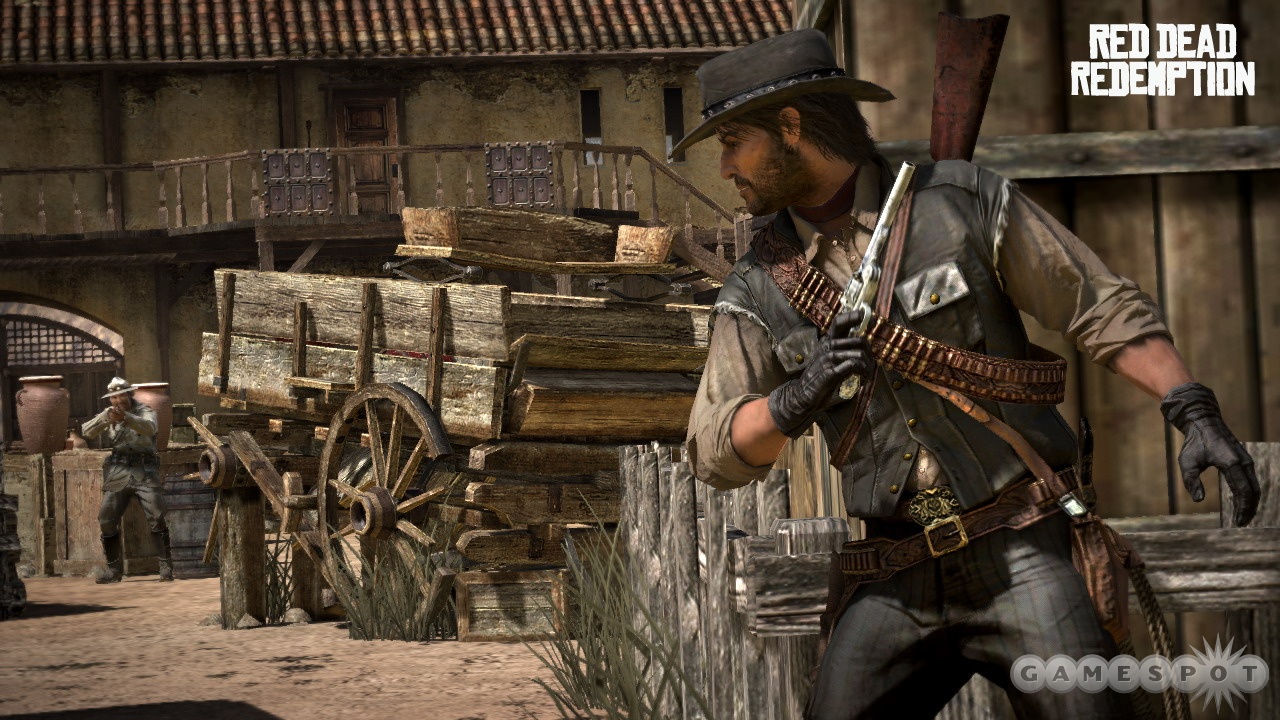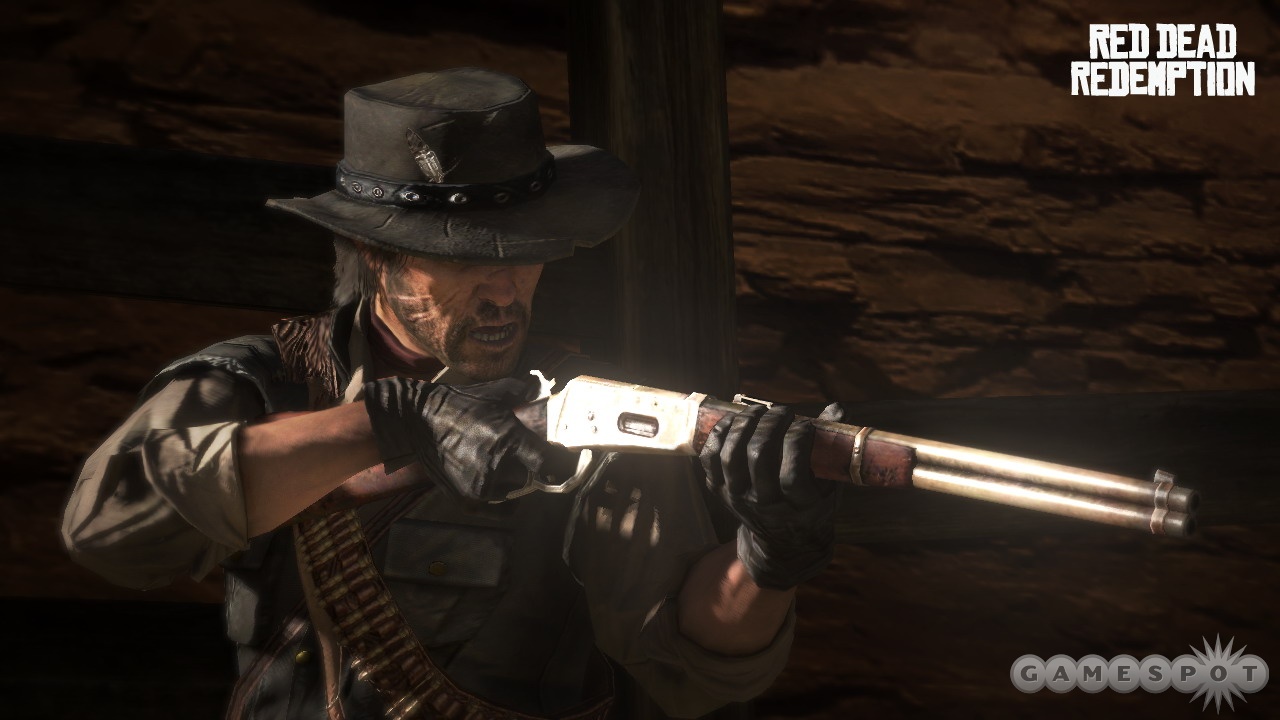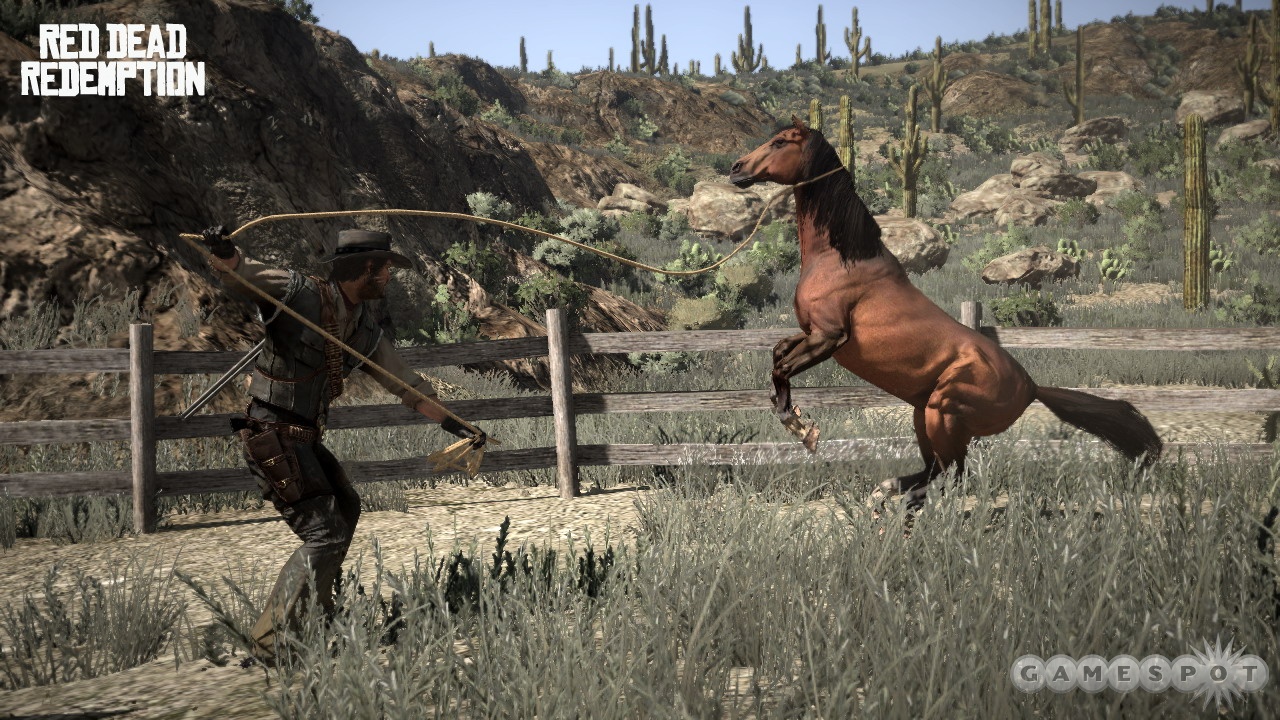Red Dead Redemption Exclusive Q&A
Rockstar San Diego talks about the creative and technical process of building a free-roaming shooter set in the Old West.
If there's one type of game that Rockstar has left an irreversible mark on, it's open-world action. The publisher-developer's Grand Theft Auto series has grown to become the ubiquitous benchmark of the genre, but the company has got another promising game coming up with a similar structure but an altogether different look and feel. That game is called Red Dead Redemption, and it's set in a wide-open stretch of American West frontier during the early days of the 20th century. We recently exchanged some questions with Rockstar San Diego's Ted Carson, the game's technical director, on the development process.
GameSpot: Talk us through the early creative process on Redemption. What were the key features from the original game you wanted to carry over? What were the big, original ideas being thrown around?
Ted Carson: As the studio was working on Red Dead Revolver, the potential for a Wild West game on the scale of Rockstar's other games became obvious. The setting was so strong, and the possibilities in an open-world setting seemed endless. We clearly weren't going to be able to fit all those ideas into the original game, which was very much a shooter. So, the fundamental challenge for Red Dead Redemption was to keep that core shooter experience and expand on everything else. The big ideas started with the goal of an open-world game in a rural setting and then layered the really challenging, but must-have, features to make that environment successful--horses that felt right, lassos that behaved properly, a massive ecosystem of animals, and a world that was both beautiful and full of things to do.
GS: Open-world action games have exploded over the past decade. What are the major pros and cons of working within such a popular genre?
TC: Luckily for us, Rockstar has a tremendous amount of experience in making some of the most successful, popular, and critically acclaimed open-world games, from the Grand Theft Auto series to Bully to the Midnight Club series and even Smuggler's Run. Unluckily for us, Rockstar also has very high standards! We knew we would have to make the game something really special for it to stand up alongside GTAIV.
As a company, we have a very clear idea of the kinds of worlds we want to make and how to make them, what works and what does not work, and that gives us a great advantage in building these kind of games. Within Rockstar as a whole we had access to a lot of people with a lot of experience about how to approach the countless challenges that must be solved to make this kind of game--from how to give the player a world that has variety and feels seamless, to how the world must serve the story. Equally important, access to this experience served as an invaluable sounding board when solving the unique challenges of Red Dead Revolver. The only "con" of making open-world games is that by their nature they are challenging--simply the scale and variety of everything you have to include is a lot of work. But, the real challenge is ensuring that everything works together--huge numbers of mechanics, environments, behaviors, dialogue, characters.
GS: The American West takes up a tremendous stretch of diverse geography. How did you settle on the specific locales of the game? What is it about these areas that made them so compelling compared to other geographical options?
TC: So much of the power of a Western comes from the tight integration between the environment and the people in it, so the three large territories had to represent the most iconic parts of the West in every way, from the landscape to the architecture to the people you would find out there. New Austin covers the American frontier and all of the small towns, outposts, and military encampments that came with it. Nuevo Paraiso is further south, across a river into the Mexican border territories, filled with rebel outposts, forts from the Mexican army, and the classic adobe architecture in the Mexican villages of the period. Port Elizabeth, which we have kept fairly secret so far, represents the more civilized areas of the northwest--full of tall redwood trees, some mountains, and the beginnings of the kinds of cities we know today. We felt that this variety, along with the way the flow is experienced by the player, gave us great visual variety and a sociological variety as the player moved from wilderness to Mexico to more developed environments as the story unfolds.

GS: Redemption isn't a typical Western when you look at how late it takes place in the genre's historical window. Why the decision to set the game in the years leading up to World War I rather than the peak of the Wild West?
TC: What appealed to us about that specific place and time was the opportunities it presented to explore things in video games that had never been attempted before. By the early years of the 20th century, the frontier was already conquered, and there was a great deal of social upheaval. The cowboys, gunslingers, and stagecoaches of the mid-1800s were literally disappearing with each passing day.
At the same time, tremendous advances were being made in technological endeavors, from weapons to communication to transport and medicine. It was the perfect environment for the kind of open-world game we had in mind: it was rich in characters, socially complex, incredibly beautiful, and, of course, presented a really wide range of really interesting weapons, along with a civil war that is brewing in Mexico!
GS: Tell us about how the protagonist, John Marston, came together. What is it about this person that makes him a good fit for this style of game or the center of this story?
TC: What makes Marston the perfect protagonist for this game is that he has a foot in both the old world and the world that was to come. As a former outlaw, Marston is someone who is used to the risks and struggles of survival on the frontier. But that's a life he left behind when his gang left him for dead after a heist gone wrong, and in the years since, he's worked at being a man of peace, working the land and raising a family.
At the same time, the government was working ruthlessly to bring the outlying territories under the rule of law. Marston's former gang were still out there, and Marston had a history as a ruthless and violent man--just the kind of tool the government needed on the frontier to finally assert the rule of law and order. The combination of good and bad and of cynicism and idealism that he represents is what made him interesting as a character. For a game of epic scope we felt that you needed a nuanced character, as opposed to a straightforward hero or villain, to provide enough interest for the player through the full experience. We are really pleased with how he evolved as a character--he's a good guy in a very difficult situation, but at the same time, he's a coldhearted killer.

GS: Rockstar games--and the Grand Theft Auto series in particular--have famously paid tribute to a lot of films over the years. Some famous movies and some obscure ones. Have those cinematic nods made their way into Redemption?
TC: Of course! It's a Western. We really wanted to explore the myths and realities of the Old West--we did plenty of real-world research, from visiting the Library of Congress to road trips to photographing real environments. But we also wanted to look at the myths of the Old West, and so many of those myths are from movies. The one thing we really focused on, above all, was to make sure that we provided, in gameplay, as many classic Western situations as we could think of. These were things we had all seen, but never experienced interactively in a game before--things like Mexican standoffs, driving stagecoaches, taming wild horses, lassoing bandits who are trying to escape, riding with the cavalry, blowing up bridges, hunting buffalo, and so and on. We really wanted the game to offer the complete Western experience interactively and stylistically to show both the idealism and brutal cynicism of the Wild West.
GS: Open-world games tend to live and die by the amount of content they offer up outside of the primary story missions. It's no small feat that Redemption seems to offer a lot of potential for side pursuits when you consider the mostly rural landscape between towns. Tell us how you went about populating this world with gameplay options when so much of it could have been barren Western frontier.
TC: Filling the vast wilderness between the townships and outposts was one of the greatest development challenges of Red Dead Redemption, and we're really excited about the results we have achieved. Unlike a city-based game like Grand Theft Auto, there are vast expanses of unpopulated open space, which we had to bring to life in a believable way, but was also full of cool things to do from a gameplay point of view. Of course, we started with a complete ecosystem and food chain with over 40 in-game animals, all of which you can hunt and skin.

In addition to that, more than any of our other games, there are countless ambient, completely dynamic events to discover. You might meet an official needing help apprehending escaped criminals that were being transported, or a woman being attacked by an unwanted suitor, or you might be attacked by a bear. All of these are contextual, depending on where you are in the world, the time of day, even what you may be wearing at the time (some outfits aren't just cosmetic and play a very important part in the way the world reacts to you). Luckily, the setting, the time period, and the subject matter, once we really got our head around them, gave us a huge amount of material to make into side missions, side characters, minigames, and things to see and watch.
All of these activities are optional, with their own specific risks and rewards. They make journeying from place to place more eventful, if you choose to stop and take part. But if you are in a hurry to move from place to place, you can ignore them completely, or just flag down a passing stagecoach. You can also quick travel to any town you have visited straight from your campsite. We really wanted to focus on giving the player a massive array of content and the choice to do what they want when they want, which we believe is at the heart of the open-world experience.
GS: Can you explain the honor system to us? What was the reasoning behind putting in a persistent system that tracks a player's moral choices when so many open-world action games go out of their way to let people wreak havoc on their surroundings?
TC: The concepts of honor and fame seemed like a way to push beyond concepts we'd explored in our other games, and these concepts are very much in keeping with the idea of morality and notoriety that the West was associated with at the time. Honor indicates how lawful and respectable a player is, while fame is an indicator of how much experience the player has had in the world. So whatever you choose to do, the more time you spend being active and making decisions in the world--whether it's through completing story missions, side missions, killing a criminal (or civilian!), or simply getting arrested--you will become more famous. People will respond to you differently depending on your level of Fame--instead of ignoring you, they might ask you for help, or challenge you to a duel in order to make a name for themselves.
Honor will fluctuate based on the choices you make. Killing a criminal is more honorable than killing a sheriff's deputy, for example. Saving a prostitute from being attacked by someone in a local bar is an honorable thing to do, but killing a merchant in order to steal from his wagon is not. A more honorable man might be offered discounts by the town's merchants, while behaving dishonorably might intimidate civilians into turning a blind eye to your crimes.

GS: The duo of Rage (Rockstar's internal engine) and Euphoria (an animation system from Natural Motion seen in games like The Force Unleashed) combined to make Grand Theft Auto IV look and feel very natural, in terms of graphics and the way things moved in the game. Can you tell us in layman's terms what sorts of improvements you've made to that tech during the development of Redemption (the immediately noticeable improvements as well as the more subtle ones)?
TC: When we first saw Natural Motion's technology, we felt that it represented the future of character physics for any shooter and knew we had to have a system like that in our games. Natural Motion provides us with a physically based character performance system that we have tightly integrated into Rage's proprietary physics engine. Instead of using canned animations, key injury and death reactions can now be accomplished entirely within a physics simulation. While staggering and falling, characters will realistically collide with nearby props and tumble down slopes. Because of its tight integration with Rage physics (rather than a third-party physics package), we are able to leverage all the benefits that our own highly optimized physics engine provides.
For Red Dead Redemption, we invested a great deal of effort into creating a natural-looking stagger/fall performance--critical to dramatic and unique gunshot reactions in a classic Western environment. Instead of fighting to maintain upright balance like characters in GTAIV, characters who get knocked over will "ride the momentum" of the impact like a real stunt man would. When colliding with the environment, the resulting reaction is not just physical, but performance-based--for example, glancing impacts with walls use true body mechanics to spin the character away, flip over a railing, fall down the stairs, get dragged by a horse, or whatever the environment calls for.

Also new to Red Dead Redemption are body-part-specific gunshot reactions that were created specifically for this game. Characters will react differently to gunshots to their gut, back, legs, arms, and torso. Characters who are suffering from a gut injury will physically crawl away from their attacker until they eventually bleed out. You can shoot their legs as they crawl away, and the legs will lose strength. Even horses have physical death behaviors in Red Dead Redemption--to mimic stunt horses from Western films. When they fall, they raise their heads to avoid the ground, and a realistic tendon simulation keeps their hind legs in anatomically accurate poses. Our proprietary animation tools provide us with the ability to dynamically mix and match Natural Motion behaviors and tightly integrate Natural Motion behaviors with the game engine like never before.
GS: Thanks for your time.
Got a news tip or want to contact us directly? Email news@gamespot.com

Join the conversation